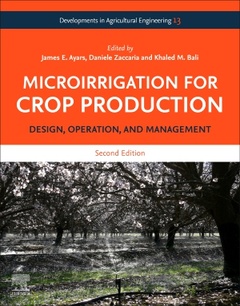Microirrigation for Crop Production (2nd Ed.) Design, Operation, and Management
Langue : Anglais

Microirrigation for Crop Production: Design, Operation, and Management, Second Edition is the latest release in this go-to foundational resource for the basics of engineering and the science of the design and operation of micoirrigation systems. This new edition includes novel methods for measurement and estimation of evapotranspiration, resource-efficient microirrigation design and operation, advanced irrigation scheduling methods and tools, novel methods and technology of microirrigation automation, monitoring and control, updates in crop salinity tolerance and leaching practices, variable rate irrigation, updates on the use of biological effluents and chemicals and pesticides to include safety and regulatory concerns.The revised book will provide an understanding on the basic science needed to comprehend systems design, operation, management, maintenance, monitoring and performance evaluation.
1. Soil Water Concepts2. Irrigation Scheduling3. Salinity4. Economic Implications of Microirrigation5. General System Design Principles6. Surface Drip Irrigation7. Subsurface Drip Irrigation8. Bubbler Irrigation9. Micro-sprinkler Irrigation10. Automation11. Application of Chemical Materials12. Application of Biological Effluents13. Field Performance and Evaluation14. Maintenance
Dr Ayars is a retired Research Agricultural Engineer with the USDA-ARS, an irrigation/drainage engineer responsible for developing research on the integrated management of irrigation and drainage systems in arid and semi-arid areas.
Honored by the California Chapter of the American Society of Agronomy, he also received multiple awards including long-term membership in Sigma Xi, Gamma Sigma Delta and Alpha Epsilon Honor Societies in Agriculture and Agricultural Engineering. He was awarded the Sir Frederick McMaster’s Fellowship by CSIRO in Australia, received the USCID Merriam Award for Improved Irrigation and the Royce J. Tipton Award from the Environmental and Water Resources Institute of the American Society of Civil Engineers for his work.
In his 40 year career, he served the research community and agricultural industry in a wide range of offices and committee assignments including extensive experience working on a United Nations Development Project in Uzbekistan to improve irrigation and drainage water management.
Dr. Daniele Zaccaria worked for the International Center for Advanced Mediterranean Agronomic Studies (CIHEAM) actively involved in research, extension education, capacity building and technical development projects in several Mediterranean, Middle-Eastern, North-African and central Asian countries, with focus on design and performance assessment of irrigation delivery networks and on-farm irrigation systems, modernization of irrigation infrastructures, water resources planning, and training for capacity building in the agricultural water management sector. He also worked as a professional designer of micro-irrigation systems for horticultural crops and has reviewed a large number of irrigation projects in southern Mediterranean countries.
His expertise and current work at UC Davis focus on research, technical development, and extension education on agricultural water management and irrigation under limited water supplies,design
Honored by the California Chapter of the American Society of Agronomy, he also received multiple awards including long-term membership in Sigma Xi, Gamma Sigma Delta and Alpha Epsilon Honor Societies in Agriculture and Agricultural Engineering. He was awarded the Sir Frederick McMaster’s Fellowship by CSIRO in Australia, received the USCID Merriam Award for Improved Irrigation and the Royce J. Tipton Award from the Environmental and Water Resources Institute of the American Society of Civil Engineers for his work.
In his 40 year career, he served the research community and agricultural industry in a wide range of offices and committee assignments including extensive experience working on a United Nations Development Project in Uzbekistan to improve irrigation and drainage water management.
Dr. Daniele Zaccaria worked for the International Center for Advanced Mediterranean Agronomic Studies (CIHEAM) actively involved in research, extension education, capacity building and technical development projects in several Mediterranean, Middle-Eastern, North-African and central Asian countries, with focus on design and performance assessment of irrigation delivery networks and on-farm irrigation systems, modernization of irrigation infrastructures, water resources planning, and training for capacity building in the agricultural water management sector. He also worked as a professional designer of micro-irrigation systems for horticultural crops and has reviewed a large number of irrigation projects in southern Mediterranean countries.
His expertise and current work at UC Davis focus on research, technical development, and extension education on agricultural water management and irrigation under limited water supplies,design
- Presents a detailed explanation and examples of systems design, operation, and management specific to the latest types of microirrigation systems, as well as sample irrigation schedules
- Assesses the proper use of irrigation technology and its effects to increase efficiency and crop productivity
- Includes illustrations of design options and charts of systems typologies
Date de parution : 11-2023
Ouvrage de 526 p.
21.4x27.6 cm
Thèmes de Microirrigation for Crop Production :
© 2024 LAVOISIER S.A.S.



